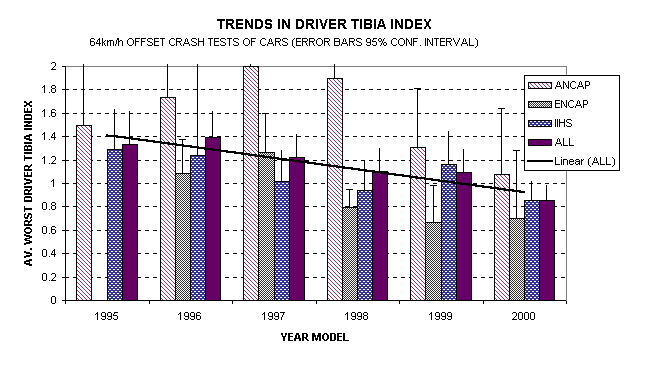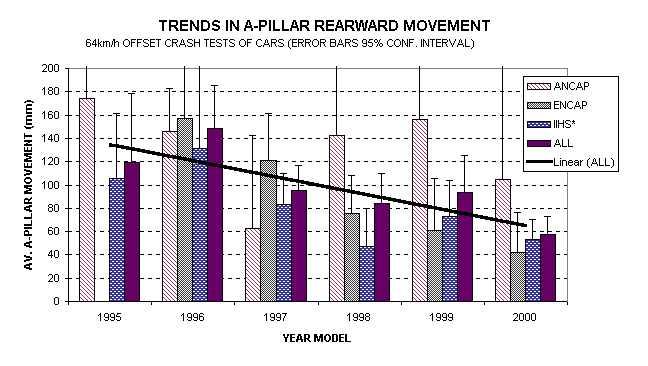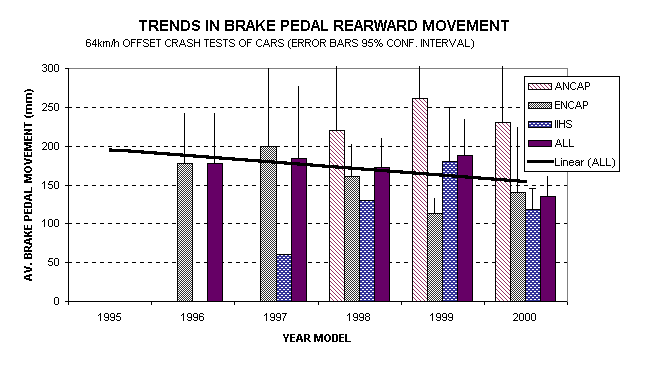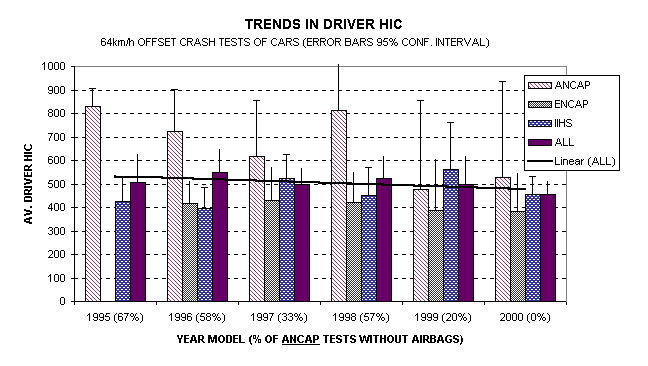Injury and deformation trends with offset crash tests
Michael
Paine, Vehicle Design and Research
Michael Griffiths, Road
Safety Solutions
Australia
17th ESV
PAPER 64
[Introduction] [Sampling Issues]
[ Results - Injury Measurements] [Results
- deformation measurements]
[Discussion] [Conclusions]
[Summary of EuroNCAP assessment scores]
Abstract
Deformable barrier, 64km/h offset crash tests are conducted under
international New Car Assessment Programs. Injury and deformation data
from more than 140 offset crash tests carried out since 1995 by EuroNCAP,
the Insurance Institute for Highway Safety and Australian NCAP have been
analyzed.
Trends for head protection, leg protection and structural performance
are discussed. The test results confirm that increased uptake of front
airbags in Australia has brought about an improvement in head protection.
Improvements in structural performance appear to have led to improved leg
and foot protection globally.
Vehicle designs have evolved to provide better occupant protection in
offset crashes. Consumer crash test programs have accelerated this process.
Introduction
The Australian New Car Assessment Program (ANCAP), US Insurance Institute
for Highway Safety (IIHS) and EuroNCAP have conducted 64km/h offset crash
tests since the mid 1990s. Details of test results are available from these
organisations, allowing us to compile a sizeable database of injury and
deformation measurements for most of the crash tests. This paper sets out
the results of our preliminary analysis of offset crash test results for
142 models of passenger car ("people movers" and sports utility vehicles
were excluded). Results have been analysed by year model to check for trends
over the last 6 years.
Sampling Issues
Due to gaps in the data, the sample does not cover all cars tested over
the evaluation period. Table 1 sets out the number of vehicles analysed,
by each test organisation and year model.
Note that the sample sizes in some cells were small. To assist in interpretation
of the results the graphs in this paper include confidence intervals based
on a t-distribution at a 95% confidence level.
Driver Tibia Index
Separate tibia index values are calculated for left and right legs and,
for recent tests, for the upper and lower tibia. The worst of these four
readings is used in the analysis (as it is for scoring under the EuroNCAP
protocol). Results are plotted in Figure 2.

There appears to be a strong downward trend (that is, reduced risk
of serious injury) over the six years but this is only marginally significant
due to the large confidence intervals.
The EuroNCAP assessment protocol rates a tibia index under 0.4 as "good"
and more than 1.3 as "poor". The overall (global) average by 2000 was 0.85
so there is still room for substantial improvement.
Results - deformation measurements
A-Pillar Movement
Residual rearward displacement of the A-pillar (adjacent to the upper
hinge of the front door) gives an indication of the integrity of the passenger
compartment. Large displacements are usually associated with catastrophic
collapse of the roof, driver's door and floorpan (Paine and others, 1998).
EuroNCAP applies a "chest score modifier" to A-pillar displacements
greater than 100mm, scaling up to a 2 point penalty at 200mm displacement.
IIHS does not report A-pillar displacement but does report the reduction
in the width of the driver's doorway. This has been used as a surrogate
for a-pillar displacement in the analysis.
Results are plotted in Figure 3. There appears to be a strong downward
trend over the six years for EuroNCAP, IIHS and combined (global) data.
However, ANCAP data is inconclusive due to large confidence intervals.

* Door width reduction evaluated for IIHS results
Brake Pedal Movement
Residual rearward displacement of the brake pedal gives an indication
of one source of injury to lower legs. It is also an indicator of firewall
deformation.
In the absence of injury measurements for dummy feet the EuroNCAP protocol
derives a "foot score" from rearward brake pedal displacement. A maximum
(good) score of 4 points is obtained if the displacement is less than 100mm
and zero points is obtained if the displacement is 200mm or more. The worst
of foot score and the two tibia scores is used for the lower leg score
under the protocol.
Results are plotted in Figure 4. There is a slight downward trend for
combined (global) values, indicating reduced risk of injury. Data for the
early years of ANCAP and IIHS tests were not available. IIHS showed a peak
in 1999 but the confidence interval was large, suggesting a large variation
in results for that year.

Discussion
Caution is needed when interpreting these preliminary results. The sample
sizes and, in some years, the large variation between vehicles produced
large confidence intervals.
Also the trends may be affected by the selection methods used by the
test organisations. For example, 1996 had a greater proportion of small
cars (63% of all tests) compared with 1999 (38%). Furthermore, the mix
of "luxury" and "cheap" cars may vary from year to year.
In Australia the publication of NCAP crash test results has increased
consumer awareness and has led to faster uptake of airbags.
In Europe and the USA airbags are almost universally fitted and there
appears to have been no change in the head protection provided by airbags
over the six years of the analysis. Since the average HIC for airbag-equipped
vehicles is well into "good" range (for EuroNCAP rating purposes) it could
be argued that the offset test program will not lead to further airbag
improvements. However, both EuroNCAP and IIHS assessment protocols take
into account airbag performance issues such as unstable head contact (head
rolling off the side of the airbag) and the airbag bottoming out. These
are likely to have an influence on airbag and steering column design.
Footwell and floorpan design appear to be receiving greater attention
from vehicle designers. This can be attributed, in part, to the consumer
offset crash tests that can be very demanding on the vehicle structure
in this region. Structures that channel crash forces around the vulnerable
footwell area are becoming more commonplace (Paine and other 1998).
Conclusions
Subject to caution about sample sizes and confounding factors, this analysis
of injury and deformation data from 142 offset crash tests of cars performed
under Australian, European and USA consumer crash test programs has revealed
that, between 1995 and 2000, there was:
a clear advantage from airbags for head protection (as indicated by HIC)
but no clear improvement for airbag-equipped vehicles over the period.
indications of an improvement in lower leg protection (as indicated by
tibia index) over the period but brake pedal displacement shows no clear
reduction and
a clear improvement in structural performance (as indicated by residual
a-pillar displacement)
Consumer crash test programs continue to be influential in the design of
new vehicles.
References
Griffiths M. (1996) Consumer crash test programs - international harmonisation
and scope for injury reduction. Proceedings of 15th ESV, Melbourne.
Griffiths M., Paine M. and Haley J. (1999) Consumer crash tests: the
elusive best practice. Symposium on Worldwide Harmonization of Crash Test
Programs, Cologne, December 1999.
Hobbs A. (1996) United Kingdom [status report]- New Car Assessment Program.
Proceedings of 15th ESV, Melbourne.
Hobbs C.A., Gloyns P.F. and Rattenbury S.J. (1999) Assessment Protocol
and Biomechanical Limits, European New Car Assessment Program, TRL May
1999.
IIHS (1996) Crashworthiness Evaluation: Offset Barrier Crash Test Protocol,
Version III. Insurance Institute for Highway Safety.
IIHS (2000a) Crashworthiness Evaluation: Guidelines for Rating Restraints
and Dummy Kinematics. Insurance Institute for Highway Safety, March 2000.
IIHS (2000a) Crashworthiness Evaluation: Guidelines for Rating Structural
Performance. Insurance Institute for Highway Safety, May 2000.
Paine M., McGrane D and Haley J (1998) Offset crash tests - observations
about vehicle design and structural performance. Proceedings of 16th ESV,
Windsor. Online at http://www4.tpg.com.au/users/mpaine/offset.html
Zuby D. and Farmer C. (1996) Lower extremity loads in offset frontal
crashes. Proceedings of 15th ESV, Melbourne.
Acknowledgements
The assistance of ANCAP, IIHS and EuroNCAP in providing test data, comments
and documentation is gratefully acknowledged.



